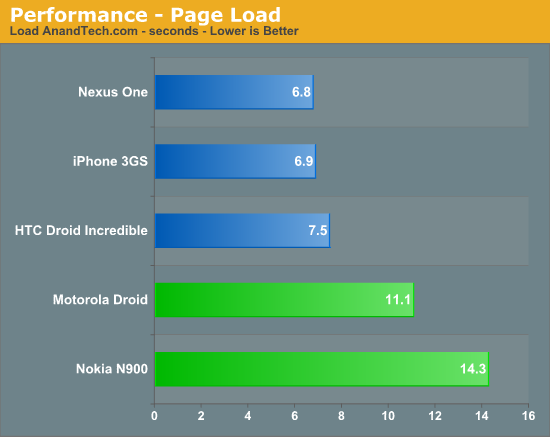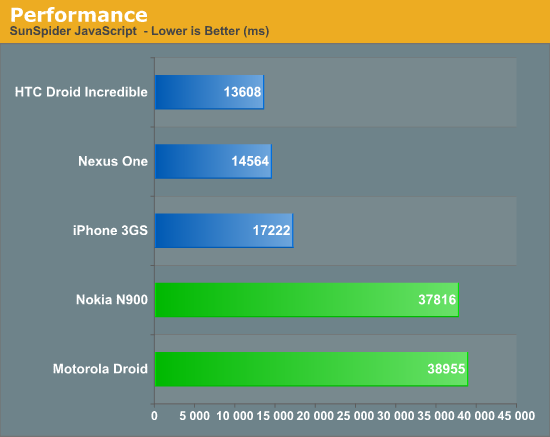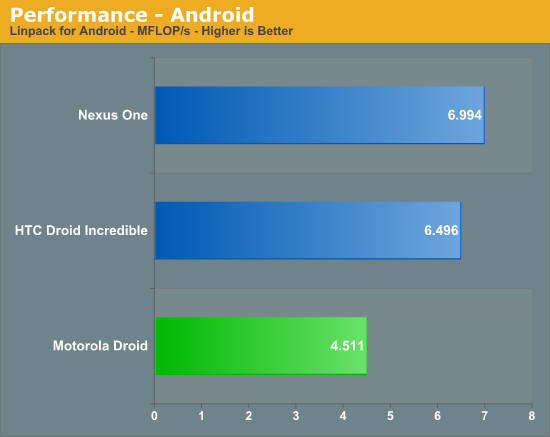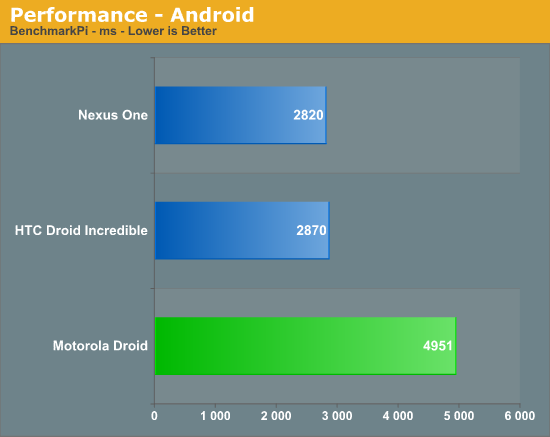Two OMAP 3430 Phones: Nokia N900 and Motorola Droid
by Brian Klug on June 10, 2010 9:29 PM EST- Posted in
- Smartphones
- N900
- Maemo
- Motorola Droid
- Droid
- MeeGo
- Android
- Mobile
Middling Performance
To measure performance, I continued using the WiFi page loading test methodology Anand described in his HTC Droid Incredible review, and also added in a few other tests that are android specific.
Our first test is loading the AnandTech.com front page, where we've got lots of text and images to stress bandwidth and parsing.

Next is the very intensive engadget.com homepage load. There are a number of flash elements here, taxing the HTC Incredible and N900 alike.

We also continue to run the SunSpider 0.9 JavaScript benchmark. This interestingly enough will illustrate the huge JavaScript performance delta between the N900's Maemo browser and the Android browser, however the comparison across Android devices gives a good idea how much the OMAP 3430 differs from the Qualcomm Snapdragon.

Common to the Android platform are two benchmarking applications that have slowly seen a rise in popularity - Linpack for Android and Benchmark Pi. Here we can get a good idea of the performance difference between the OMAP 3430 and the Snapdragon SoCs.


We can see that the OMAP 3430 holds its own, but still just isn't as fast as the 1 GHz Snapdragon SoC. What's interesting here is that the Motorola Droid's Cortex A8 is running at 550 MHz, some 81% slower than the 1 GHz Snapdragon. However, the performance difference between the two is only 44% for Linpack. Benchmark Pi numbers are closer to the kind of scaling I'd expect, as the 81% increase in clock speed results in a 73% faster compute time.
In practice the N900 is undoubtably a snappy phone. While using Maemo, I never once wanted for more power, even though users have successfully achieved 1 GHz or more on the OMAP 3430 in the N900 and Motorola Droid. Only after getting 8 or more webpages open did I really start to notice any lag or slowdowns at all. On the Motorola Droid, Android 2.1 was more than usable, and far faster in practice than the ARM11 class SoCs used in some of the other Android phones, like the 528 MHz Qualcomm MSM7600A or MSM7200A in the HTC Hero.










68 Comments
View All Comments
Zebo - Friday, June 11, 2010 - link
with 750mhz processor convex keys and ditching the lame D pad making this the best smart phone for my use talking 5-6 hours a day plus on best network instead of T or TM.krazyfrog - Friday, June 11, 2010 - link
Dude, you chat like an eight year-old lol.CityBlue - Friday, June 11, 2010 - link
The latest Maemo5 PR1.2 does bring a welcome improvement to battery life, in some cases as much as 50% improvement to standby time.The recently released Opera Mobile on the N900 is lightning fast - it would be interesting to see how that performs in your comparison tests, or the latest Fennec (Firefox Mobile 1.1). The stock MicroB browser is beginning to look a little long in the tooth what with all the Javascript run-time improvements in competing browsers, but it does still offer the most complete web experience on pretty much any mobile device.
Overall though, a very good and welcome review of Maemo5 which is much misunderstood by a world obsessed with Android and iPhone.
achipa - Friday, June 11, 2010 - link
Two small corrections:Nokia's next MeeGo device is still going to be ARM (MeeGo is a two-platform OS, ARM and Atom), if there is a Moorestown device far along in the pipelines, it's not Nokia's.
PR1.2 is very likely not the last update. Nokia has pledged to deliver QtMobility (the mobile device Qt APIs) in a future update, and there is an active Qt4.7 branch for Maemo5 which also suggests work is being done there.
The Solutor - Friday, June 11, 2010 - link
Not all the Droid/Milestone's keyboard are flat.http://img96.imageshack.us/img96/5872/dsc00180.png
http://img412.imageshack.us/img412/6551/dsc00176.p...
This is my milestone (bought in december).
So there's no need to wait droid 2 to get the raised keys.
Brian Klug - Friday, June 11, 2010 - link
Interesting... looks like they definitely identified that issue somewhere between finishing the CDMA 'Droid' design and the GSM Milestone. Cool stuff!-Brian
strikeback03 - Friday, June 11, 2010 - link
I read that elsewhere as well. Would be nice if the verizon stores got the newer keyboard models out on display to tryBoyBawang - Sunday, June 13, 2010 - link
Sorry to break your heart dude but the ones with raised keyboard were the early builds. Motorola changed it to flat after reported sliding problems with the raised designstrikeback03 - Monday, June 14, 2010 - link
Actually one of my friends got a Moto Droid Thursday and I had a chance to play with it Friday, it did feel like they had improved the key feel slightly. IIRC the Droids on display had concave keys, this one was slightly convex.solipsism - Friday, June 11, 2010 - link
I understand that's because they are in the same package is the reason why you need the BT to be on to get FM, but that can't be too common. After all, most smartphones seem to have WiFi and BT(+EDR) and FM all the same transceiver.For comparison, the iPhone 3GS uses a <a href="http://www.broadcom.com/products/Wireless-LAN/802.... BCM4325</ a>